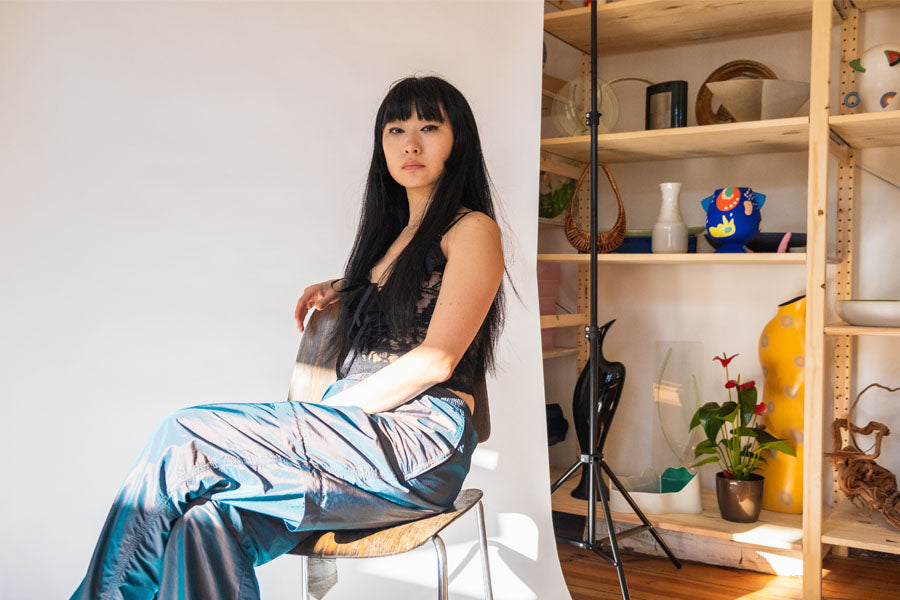Beauty, they say, is in the eye of the beholder. But some beauty only achieves its full bloom when it is shaped by an empathetic mind, attentive eyes and careful hands.
As an Ikebana artist and art historian, Han Le Han arranges bends and curves of branches, leaves as well as blossoms in expressive interaction of space, lightness, structure and color with a trained eye.
With respect for the flowers' own rhythm and the natural flow that surrounds them, Han Le creates harmonious arrangements with a meditative aura.
A highly traditional art form whose roots reach back centuries into the history of Japan. And under Han Le's interpretation, it blossoms timelessly in Berlin.
Since the exclusive opening event of This Place on 01.11.2023, her subtle installations and arrangements have symbolized the balance between handmade art and untouched naturalness. Viewing them strengthens one's inner balance and can be understood as a self-care moment of the quiet kind.
In an interview for our blog series "In Conversation", artist Han Le talks openly about the fact that even Berlin’s underbrush can be beautiful and which last private experiment made her overcome fears.
1. Han Le, as a trained Ikebana artist, you learned your craft at the most renowned and oldest Ikebana school in Japan, Ikenobō. The school was founded as early as the 15th century. In your opinion, what makes this traditional art form so timeless? And what influence do life and everyday life in Berlin have on your arrangements?
The dominant Ikebana styles have undergone numerous transformations over the centuries and are of course, like other art forms, subject to various trends and contemporary tastes.
For me, the fact that this ancient tradition has retained a timelessness and modernity is mainly due to the fact that it is deeply rooted in the realities of people's lives and needs. Ikebana is never created in a vacuum or for the sake of pure artistic expression, but in interaction with the environment. This includes spatial conditions as well as occasions such as holidays and other festivities, the reception of visitors, even something as trivial as the joy of a particularly beautiful branch or the onset of the change of season. Above all, the flow of time and thus the fleeting nature of all being are very universal constants of human existence that always resonate when creating or viewing an ikebana work.
Life and everyday life in Berlin have an influence on my arrangements as I adapt to the circumstances in the sense I have just explained. In Berlin, these often take on more extreme forms than would probably be the case elsewhere. For example, if rooms look like building sites, a classic Ikebana arrangement would not unfold its beauty there at all, and I have to resort to correspondingly anarchistic means. Otherwise, I personally like to work with local and recovered material. In Berlin, on the other hand, this means making do with a lot of underbrush and bare branches, especially in winter.
2. Without a doubt: flowers bring joy. But Ikebana as a floral design style is so much more than just typical table decoration. Unlike most bouquets, the rule here is: Less is more. What is the intrinsic beauty of the deliberate reduction to individual leaves, blossoms and branches?
Perhaps it is instructive at this point to speak of frugality or humility rather than reduction. After all, nothing is taken away in ikebana, even if it may seem that way in comparison to western floristry. On the contrary, something is added, and with such consistency that there is no room for anything superfluous. Behind this is the insight that what is already there is already good and good enough if it is brought to bear according to its characteristic qualities. Every trimming and pruning, the actual taking away in this process, serves to completely expose and make visible these characteristics, which can also find expression in a single flower.
To make do with what is already there and to help it to its most beautiful form is the real art. For this presupposes that one has understood a plant as a whole and appreciates it precisely in its individuality.

"For me, the fact that this ancient tradition has retained a timelessness and modernity is mainly due to the fact that it is deeply rooted in the realities of people's lives and needs. Ikebana is never created in a vacuum or for the sake of pure artistic expression, but in interaction with the environment."
3. In Ikebana, the free space between the individual elements is particularly important. As an artist, how do you prefer to use this space? And what does this free space trigger when you look at it?
I use free space in my arrangements mainly when I want to focus on a particular line or silhouette. Like a silhouette, a positive shape only becomes fully recognisable when it is surrounded by negative space, and vice versa. Allowing the eye to engage with an interesting detail and scan it undisturbed with the gaze can be a more stimulating viewing experience than a mass of disparate but ill-defined impressions.

"Ikebana stands for the insight that what is already there is already good and good enough if it is brought to bear according to its characteristic qualities."
4. Your Ikebana arrangements and installations are captivating in their clarity. Do you have a ritual that you rely on in stressful times to first find clarity within yourself?
For me, food definitely fulfils this function. Eating a good meal has always been one of the few activities where I can completely switch off without much effort. When I'm in over my head or I realise I need to calm down, I drop everything and go to a nearby café or restaurant, even if I'm alone, where I look forward to the tastes that await me. My friends sometimes find it very entertaining how slowly and extensively I can dine, and that I sometimes have to stop a conversation to concentrate on the food.
5. You have dedicated yourself to experimental floral art. But what was the last experiment you dared to undertake as a private person?
One of the greatest experiments of the last few years was certainly to leave my carefully developed career as an art historian, which was embedded in institutional structures, and to go into artistic self-employment. This step was connected with an unbelievable number of very existential fears, which I had left untouched until then, not without reason. At the same time, I think it was through this that I first understood what it means to take responsibility for one's own desires, goals and decisions.
"Allowing the eye to engage with an interesting detail and scan it undisturbed with the gaze can be a more stimulating viewing experience."
Portrait©Patrycja Toczek

